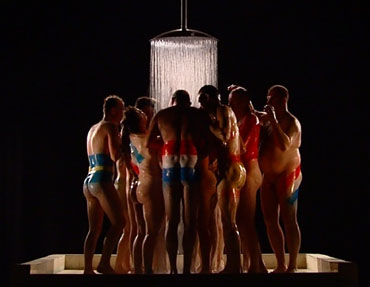 |

Europa tar en dusch, stillbild ur Peter Greenaways kortfilm "The European Showerbath", 2004 |
 |
SVART/VIT | FÄRG - OM EUROPEISK MEDIEMODERNITET
22 september – 15 november
Mediebilderna av Europa växlar. Den europeiska historien är som en kornig, svartvit stumfilm medan dagens mångkulturer framträder i granna TV-färger. Den europeiska identiteten har medialt gestaltats på många sätt, från Svenska Bios stumma antimigrationsmelodram ”Emigranten” till von Triers filmnoirpastisch ”Europa” ? eller dagens kritiska tv-reportage som programmet ”Vem bestämmer i Europa?”. Audiovisuella medier har länge dominerat hur Europa uppfattas. De förmedlar en självbild som de också aktivt konstruerar. Men på vilket sätt är Europa en produkt av mediehistorien? Kan begreppet ”Europa” rentav reduceras till en medial föreställning? I en serie kortfilmer, ”Visions of Europé” av regissörer som Fatih Akin, Greenaway, Troell och Kaurismäki kring EU:s utvidgning, framkallas exempelvis bilden av ett byråkratiskt Europa distanserat från kontinentens folk. Men det finns också motbilder ? inte minst i mediehistorien. Från den bejakande FN-kortfilmen I ”Europas tjänst” från femtiotalet till Péter Forgács mörka men hoppingivande stämningar från krigsåren, gestaltat genom återbruk av europeiska amatörfilmer. I en digital utställning och en föreläsningsserie på Statens ljud- och bildarkiv ? ett av Europas största mediearkiv ? framträder den europeiska mediemodernitetens förvandlingar.
BLACK & WHITE | COLOUR - ON EUROPEAN MEDIA MODERNITY
The media images of Europe vary. While the European history is like a grainy black and white silent film, the multicultures of today appear in brilliant television colours. The media representations of European identity has also differed, from Swedish Biograph's silent anti-immigration melodrama “The Emigrant”, to the film noir pastiche “Europa” by von Trier – or today’s critical television documentaries as “Who decides in Europe?”. Audiovisual media have, thus, long dominated the perception of Europe. Media communicates a European self-image ? which they also actively construct. But in which way is Europe a product of media history? Could the concept of ”Europe” in fact be reduced to a media phenomenon? In a series of short films, “Visions of Europe”, concerning the extension of the EU by directors like Fatih Akin, Greenaway, Troell, and Kaurismäki, there appears the image of a bureaucratic Europe alienated from the people. Counter images and contrasting perceptions exist, however, not the least in media history. From the positive UN short “In Europe's service” made in the fifties, to Péter Forgács’ dark but promising imagery from the war years, shaped through re-use of European amateur films. These changes in European media modernity are presented at a digital exhibition and a lecture series at the Swedish National Archive of Recorded Sound and Moving Images ? one of the major media archives in Europe.
|
|  |
|











